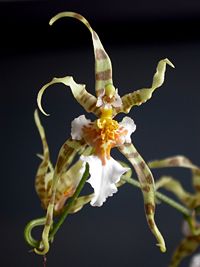Phymatochilum
| Phymatochilum | ||||||||||||||||||||
|---|---|---|---|---|---|---|---|---|---|---|---|---|---|---|---|---|---|---|---|---|
 | ||||||||||||||||||||
| Scientific classification | ||||||||||||||||||||
| ||||||||||||||||||||
| Type species | ||||||||||||||||||||
| Oncidium phymatochilum Lindl. 1848 | ||||||||||||||||||||
| Species | ||||||||||||||||||||
| ||||||||||||||||||||
| Synonyms | ||||||||||||||||||||
|
Phymatochilum is an orchid genus formed by only one species, Phymatochilum brasiliense, inhabitant of Serra do Mar mountains in Brazilian southeast and northeast, which vegetatively resembles Oncidium species, however, is more closely related to the genus Miltonia.
Distribution and habit
Phymatochilum brasiliense is a comparatively large sympodial epiphyte species which inhabits high areas of the Atlantic Forest of Rio de Janeiro, São Paulo, Espírito Santo and Pernambuco States of Brazil,[1] particularly in the warmer areas around Serra do Mar chain of mountains, where it is somewhat rare. It grows under the shadow of trees, however, mostly near the jungles well ventilated clearances where it can get brighter light, between 600 and 1,300 meters of altitude in dryer areas. It ordinarily grows over the trees where the shade is not intense, on thick branches.[2]
Description
| Measures (mm) | ||
| Structure | Lenght | Width |
| Rhizome | 15 | 15 |
| Leaf | 500 | 100 |
| Pseudobulb | 100 | 70 |
| Inflorescence | 1800 | - |
| Flower | 50 | 25 |
| Sepal | 35 | 3 |
| Petal | 25 | 3 |
| Labellum | 18 | 12 |
Phymatochilum brasiliense blooms between from the end of summer to middle autumn and its sweet fragrant flowers last for about two weeks. There is no reference about their pollinators.
Taxonomic notes
References
- ↑ Pabst, Guido & Dungs, Fritz : Orchidaceae Brasilienses vol. 2 p. 195. Brucke-Verlag Kurt Schmersow, Hildesheim, 1978. ISBN 3871050107
- ↑ Baker, Charles O & Baker, Margaret L. (2006), Miltonia phymatochila in Orchid Species Culture Oncidium/Odontoglossum Alliance: 345, Timber Press. ISBN 9780881927757